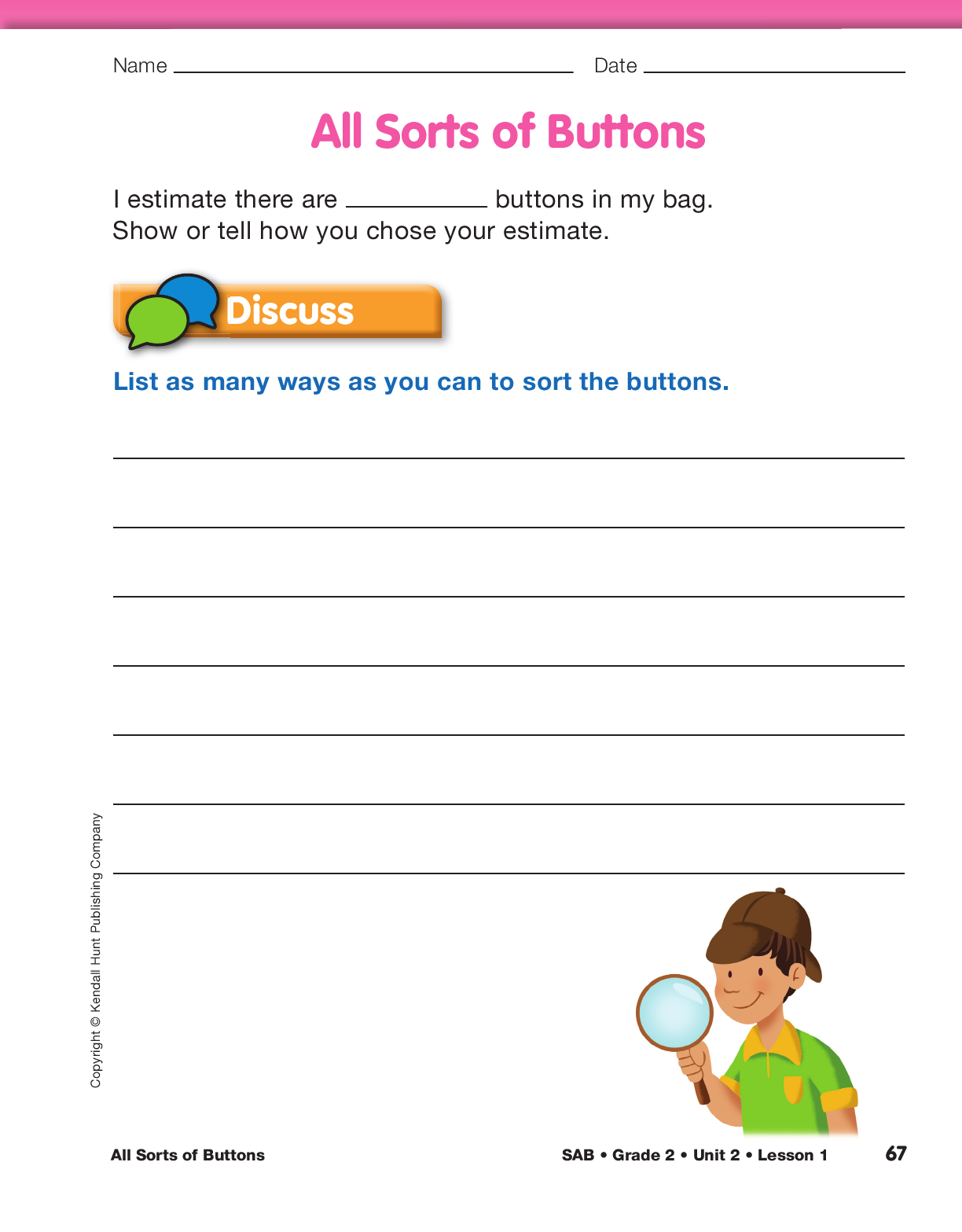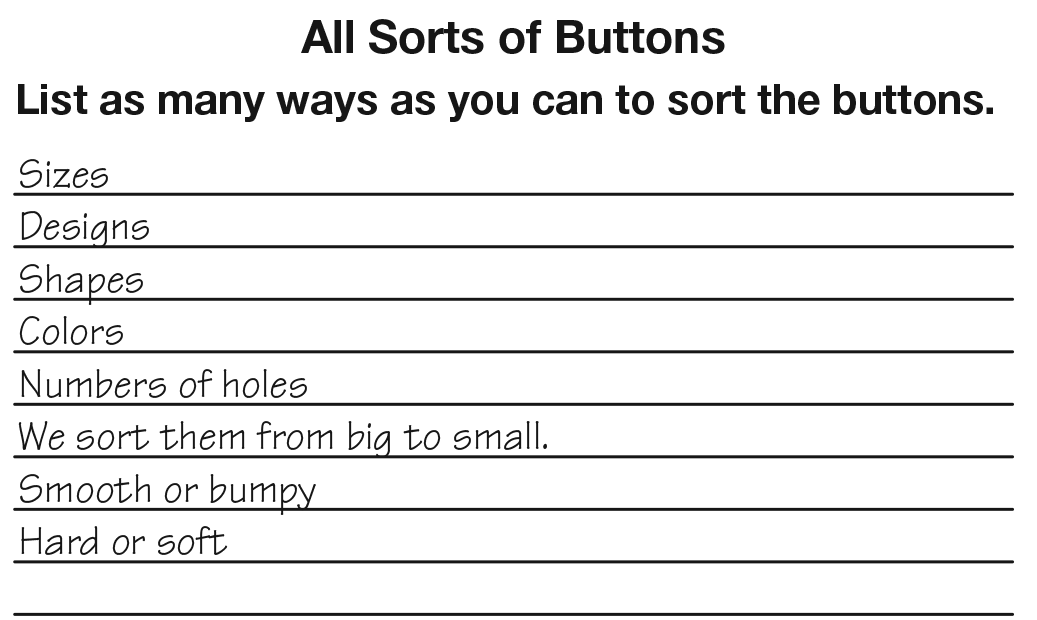Introduce the Button Activity. Read the book The
Button Box by Margarette S. Reid as an introduction to this unit.
-
Look at the picture of the buttons in the box on the
second and third page. What do you notice about
the buttons? (Possible responses: There are buttons
with different colors, shapes, number of
holes, sizes.)
After reading the book, discuss various characteristics
of the buttons that the boy and his grandmother
noticed about the buttons.
- Which buttons did the boy in the story sort first? (The buttons with the flowers painted on them.)
- What are some other ways he sorted the buttons?
(Possible responses: He sorted the buttons by
color [rainbow pattern], by size, by material
[cloth, metal, wooden, glass, stone] by number of
holes, and by thickness.)
- What kind of clothes did he think of when he saw
some of the buttons? (Possible responses: Cloth
buttons made him think of fancy clothes; metal
buttons of overalls and jeans; shiny ones of
uniforms.)
- What game did the boy and his grandmother play
with the buttons? (They closed their eyes, took
out one button each, and compared the two buttons.)
- What does the boy like about the buttons?
(Possible responses: He pretends he’s rich; he
likes the way they sound; there are so many different
kinds; he can imagine where they came
from.)
- What did you learn about buttons? (Possible
responses: Kings would wear buttons to show
how important they were; different clothes have
different kinds of buttons; buttons without
sewing holes have shanks on the back; you can
play games with buttons or imagine where they
came from.)
Use Benchmarks to Estimate the Number of
Buttons. Divide the class into pairs and give each
pair a bag of buttons. Tell students they will first
make an estimate of the number of buttons in their
bags.
Remind students to not open their bag of buttons until they have made an estimate.
- Who remembers what an estimate is? (Possible responses: a good guess; a “close to” number)
- What's the difference between an estimate and an
exact answer? (Possible responses: An estimate is
a good guess. It is when you guess “about” how many before or after you solve the problem to
see if the exact answer is reasonable. You make
estimates when it's impossible or very hard to
find the exact number or when you don't need to
know the exact number. The exact answer is what
you get when you actually count or do the computation.)
- How do we find an estimate? (Possible response:
We look and use what we know to figure out “about” what the number will be.)
- What kind of information do we use to make an
estimate? (Possible responses: Our past experiences;
what we know about numbers and counting.
We can compare one bag to a bag of buttons
in which we know the exact number.)
Show students the benchmark bags of buttons hanging
above the class number line. See Figure 1 and
Materials Preparation. Tell them to compare their
bag of buttons to the benchmarks of 20, 50, and 80
and use the benchmarks to make a good estimate.
- There are 3 bags of buttons above the number
line. The first has 20 buttons, the second has
50 buttons, and the third has 80 buttons. We are
going to compare our buttons to the benchmark
bags of 20, 50, and 80 so we can make a good estimate.
- Which benchmark is your bag of buttons closest
to? 20? 50? 80?
- Do you have more than [benchmark number] buttons
or less than [benchmark number]?
- How many more or less?
- Estimate the number of buttons you think are in the bag.
Have students take turns holding up their button bags for their partners to estimate and write their
estimate at the top of the All Sorts of Buttons page in the Student Activity Book.
Find Ways to Sort Buttons by Characteristics.
Next ask student pairs to empty the buttons onto
their desktops. Give them a few minutes to explore
the buttons with their partners, looking for differences
and similarities. Suggest that they take turns
describing different buttons to each other. Encourage
them to try to think of as many different ways to
describe the buttons as they can.
- What are some differences that we see in the buttons?
What are some ways that some of the buttons are the same?
- If we want to sort our buttons, what are some
ways, or characteristics, that we could use to sort them?
Have students work in pairs to note their ideas for
sorting on the All Sorts of Buttons page. If necessary
to get them started, list on the board a few suggestions
from students, but refrain from making a full
list at this point. Let students generate the list of
sorting characteristics on their own.
Ask pairs how they are working together. Ask: “Are you
taking turns? Are you staying on task? Is everyone
participating?” If students answer no, make a plan to help
everyone get involved and on task.
Some students may suggest sorting the buttons by
characteristics such as color, shape, size, material,
and number of holes. Other students may suggest
sorting them by design, texture, thickness, and hardness.
Still others may prefer to use two rounds of
sorting, such as sorting by color, then grouping by
another characteristic, such as size. See Figure 2 for
an example of a completed page.
After students have completed the page, summarize
their ideas on a cumulative list. Guide students to
understand that buttons can be sorted by many characteristics.
Talk with students about the possible categories
for the characteristics. For example,
categories for size may be small, medium, or large.
For number of holes, there may be no holes (shank
on the back), two, or four.
Lead the discussion to the ways that sorting is used
in everyday life. For example, students might distinguish
storybooks from textbooks, drawing paper
from writing paper, and pencils from pens. At home,
they may sort forks, spoons, knives, and serving
utensils when setting the table. Socks are sorted by
color and size; clothes by style, warmth, and purpose.
Encourage students to name other things that
get sorted.
















